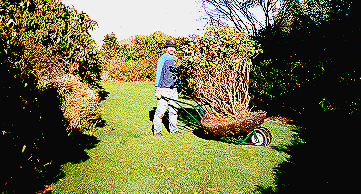
Moving a Large Rhododendron Moving a large azalea Moving a 40 year old Chinese Witchhazel
As rhododendrons grow larger, they often become too crowded. This orbiculare was overpowering its neighbors, and nearly blocked a path. Now it fills a gap on the garden border.

Moving small rhododendrons is relatively easy, since they form compact root balls with no taproot. Transplanting large ones is challenging, but often necessary. With the right techniques and equipment, they can be moved, too.
First, a word of warning: moving large rhododendrons puts a real strain on the body, even when you use the right equipment and methods. If you have any question about your heart, hire a younger person to do the job. The guidelines below are just as valuable whether you do it yourself or instruct someone else.
Pruning before transplanting large rhododendrons serves two purposes. It allows you access to the plant to dig, and the removal of top material balances the loss of roots that must be cut. The orbiculare above was more than six feet wide right to the ground prior to digging, so there was no way to reach the root ball with a spade. Within a year, it again had leaves to its base, and is nearly fully recovered after three years.
Remember that pruning can be done below ground, too. By cutting a tapered circle around the plant a year before you actually dig it, you encourage a tight ball with a net of many small, new roots near the perimeter.
| I do all my rhododendron digging with a long-handled spade. Be sure to buy a heavy-duty one, and keep the blade sharp. The new spade (left) has a steel handle for strength and momentum to cut big roots. The 50 year old one next to it had a pipe over the worn-out handle for the same purpose. I finally pried too hard with it last year. Now it is retired after moving more than 10,000 plants. I hardly ever use the 30-year-old short-handled spade, since it is so hard to stand on and rock from side to side, cutting roots. The handle on the spade at right is giving out after 25 years. All of these tools were purchased from A. M. Leonard Company. |
 |
Begin by making a few test cuts with the spade to find the edge of the fibrous root ball. In our soil, a ten-foot high rhododendron has a tight ball about three to three and a half feet in diameter, but the size varies with growth habit. The six-foot high orbiculare pictured above had a four-foot root ball. Taking too small a ball will obviously eliminate too many roots. Taking too large a ball will ironically have the same effect, because the weight of the unsupported dirt will break off large chunks of the ball. (Notice how the ball above holds its shape in transit.)
Then make a tapered cut all the way around the plant, pushing the spade down to its full depth. If this is difficult, rock the spade from side to side to cut through the roots. For additional force, stand on the spade while you rock it and ride it down until your feet touch the ground. This is a time when the long-handled spade shows its superiority over short-handled models.
Avoid the temptation to start prying the plant up before you have made a complete tapered slice all the way around the plant, or you could split the root ball. But once the rootball is completely severed from the surrounding dirt to the depth of your spade, begin prying the plant up. Again, be patient. Pry a little at a time, working your way around the plant, while forcing the spade farther under the plant. Eventually, it will break free.
Getting the very large rhododendron out of the hole is often harder than digging it. I use the spade to lift one side, then slip an eight-foot 2x6 board under it, and repeat the process on the other side. If you have loose soil, this is a good time to get heavy burlap or canvas under the plant, though here I have not found this difficult step necessary.
If you have several people to help, you can slide the rhododendron up the incline of the 2x6's. I use a lowboy plant carrier (above), so I just dig a little extra on one side and work the whole thing down into the hole. (If you can weld, you can make one of these out of pipe. This one has been moving plants for 60 years.) Other ways to transport plants are with a loader or forklift.
Replanting is the easiest part. Dig an oversized hole, line it with a few inches of good topsoil, and slide the plant into it. Study how you want it to face ahead of time so you don't have to turn it in the hole--nearly impossible with the largest rhododendrons. Fill the hole with water before filling dirt around the plant, and water again after all the dirt is in.
Rhododendrons can be moved any time of year except in the heat of summer, but late fall or winter is best. Be sure they don't dry out. Of course, don't try to move them when the ground is frozen solid. I try to do the bulk of my transplanting in November and December. Since you often have to cut a larger proportion of roots on a large rhododendron to make it manageable, it is more important to move it at an optimal time. One fall I moved more than 150 rhododendrons over six feet tall, and all have survived.